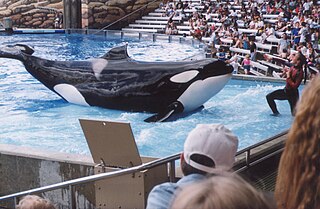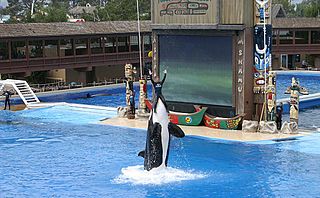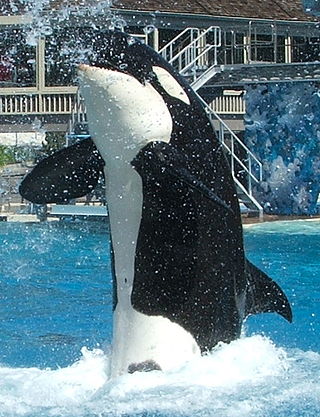
SeaWorld is an American theme park chain with headquarters in Orlando, Florida. It is a proprietor of marine mammal parks, oceanariums, animal theme parks, and rehabilitation centers owned by SeaWorld Parks & Entertainment. The parks feature orcas, sea lion, and dolphin shows and zoological displays featuring various other marine animals.

Corky II, often referred to as just Corky, is a female captive orca from the A5 Pod of northern resident orcas. At approximately the age of four, Corky was captured from Pender Harbour off the coast of British Columbia on December 11, 1969. She has lived at SeaWorld San Diego in San Diego, California since 1987. As of 2023, she is the oldest and longest kept captive orca.
Shamu was a female orca captured in October 1965 from a southern resident pod. She was sold to SeaWorld San Diego and became a star attraction. Shamu was the fourth orca ever captured, and the second female. She died in August 1971, after about six years of captivity. After her death, the name Shamu continued to be used in SeaWorld "Shamu" shows for different orcas in different SeaWorld parks.

Loro Parque or 'Loro Park' is a 135,000 m² zoo on the outskirts of Puerto de la Cruz on Tenerife, Spain where it houses an extensive and diverse reserve of animal and plant species. The park was conceived as a paradise for parrots and has developed over the years into one of the biggest attractions of the Canary Islands, with over 40 million visitors.

Katina is a female orca who lives in SeaWorld Orlando in Florida. She was captured off Iceland at approximately three years of age on October 26, 1978. She is the most successful breeding female orca in captivity.

Kasatka was a wild caught female orca who lived at SeaWorld San Diego.

SeaWorld San Antonio is a 250-acre (100 ha) marine mammal park, oceanarium and animal theme park in the Westover Hills District of San Antonio, Texas, on the city's west side. It is the largest of the three parks in the SeaWorld chain owned and operated by SeaWorld Parks & Entertainment. It is also one of the world's largest marine-life theme parks focused on conservation, education and animal rescue. It is a member of the Alliance of Marine Mammal Parks and Aquariums (AMMPA) and is accredited by the Association of Zoos and Aquariums (AZA).
Namu was a male orca unintentionally captured in 1965 from the C1 Pod of the northern resident community. He was the first captive orca to perform with a human in the water. He was the subject of much media attention, including a starring role in the 1966 film Namu, the Killer Whale. Namu's captivity introduced thousands of people to orcas, and soon aquariums all over the world sought to establish captive orcas in their parks.
Orcas are large, powerful apex predators. There have been multiple killer whale attacks on humans in the wild, but such attacks are less common than those by captive orcas. In captivity, there have been several non-fatal and four fatal attacks on humans since the 1970s. Experts are divided as to whether the injuries and deaths were accidental or deliberate attempts to cause harm.
Kotar was a male killer whale captured off the southeast coast of Iceland in October 1978. At the time of his capture, he was only 210 cm long and he is believed to be the youngest killer whale taken into captivity from the wild that survived.

Dozens of orcas are held in captivity for breeding or performance purposes. The practice of capturing and displaying orcas in exhibitions began in the 1960s, and they soon became popular attractions at public aquariums and aquatic theme parks due to their intelligence, trainability, striking appearance, playfulness, and sheer size. As of June 26, 2023, there were at least 53 orcas in captivity worldwide, 29 of which were captive-born. At that time, there were 18 orcas in the SeaWorld parks.

Dawn Therese Brancheau was an American animal trainer at SeaWorld. She worked with orcas at SeaWorld Orlando for fifteen years, including a leading role in revamping the Shamu show, and was SeaWorld's poster girl. She was killed by an orca, Tilikum. Tilikum was also involved in the deaths of two other people: Keltie Byrne and Daniel P. Dukes.

Tilikum, nicknamed Tilly, was a captive male orca who spent most of his life at SeaWorld Orlando in Florida. He was captured in Iceland in 1983; about a year later, he was transferred to Sealand of the Pacific in Victoria, British Columbia. He was subsequently transferred in 1992 to SeaWorld in Orlando, Florida, where he sired 21 calves throughout his life.

Shamu was the stage name used for several captive performing orcas at SeaWorld as part of their theatrical Shamu show beginning in 1960s. The original Shamu died in 1971, but the name was trademarked by SeaWorld, and has been given to different orcas over the years.

Ulises is a male orca who lives at SeaWorld San Diego in California. He was captured off the coast of Iceland in 1980 and is currently the oldest male orca in captivity as of 2022.

Morgan is a female orca who was rescued in the Wadden Sea, off the northwestern coast of the Netherlands in June 2010. She was found in an unhealthy condition, severely underweight and malnourished. She lived several months at the Dolfinarium Harderwijk in the Netherlands. After it became clear that the basin at Dolfinarium was too small, multiple options were considered, including releasing Morgan and transferring her to another facility. Over a year later, after litigation and debate between scientists, a Dutch court ruled that she was to be moved. Morgan was transported to the Loro Parque in Spain in November 2011.
Walter the Whale was a star orca when keeping orcas in captivity had just begun—in the 1960s. In 1967, following the death of Namu, the only other established star orca was Shamu. "Walter the Whale" was the orca's advertised name at first, but later she was renamed Skana.
The Yukon Harbor orca capture operation was the first planned, deliberate trapping of a large group of orcas. 15 southern resident orcas were trapped by Ted Griffin and his Seattle Public Aquarium party on 15 February 1967, in Yukon Harbor on the west side of Puget Sound. The first four orcas that had been taken into captivity had been captured singly, and mostly opportunistically. Those four were named Wanda, Moby Doll, Namu, and Shamu—who was then the only surviving one. Through them, interest in orcas had escalated.











